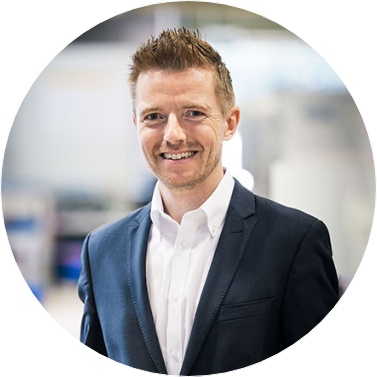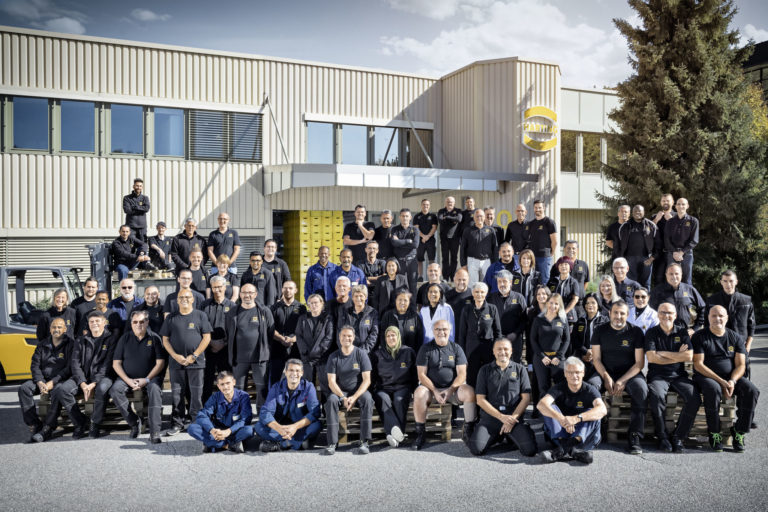




Tom Hess
Head of PM, Product &
Technology Development
Francois Roncoroni
Market & Product Manager
Hollie Finnegan
Inside Sales Technical
Claudio Sonzogni
Product & Application Manager
Stephan Schmidt
MID Sales North America

The abbreviation MID stands for “Mechatronic Integrated Device” and used to be called “Molded Interconnect Device”.
3D-MIDs are three-dimensional circuit carriers that offer the unique possibility of combining electronic and mechanical functions in a three-dimensional component.
They are based on highly flexible plastic parts that are injection molded exactly as required.
We then apply electronic conductor tracks to these parts using the laser direct structuring (LDS) process. By utilizing the three-dimensional installation space, the technology offers the highest possible degree of freedom.
The associated integration of mechanical and electronic functions in the smallest possible installation space saves space and supports miniaturization.
3D-MID has the following 4 process steps:
We are the only supplier outside Asia with the entire process chain under one roof.
There are several advantages. For example, the functional integration of electronic and mechanical components, miniaturization, simplification of subsequent assembly processes, design freedom and cost reduction.
We require a certain amount of one-off work => the basis is an injection molding process, so this technology is primarily suitable for large quantities.
The technology is an integral part of most people’s everyday lives, be it antennas for smartphones, payment devices or various medical devices or consumer electronics.
The fields of application are constantly increasing. Developers should be familiar with the possibilities of the technology at the start of a project in order to fully exploit them. Simply replacing a printed circuit board with MID makes little sense if the other advantages of the technology are not utilized.
In principle, yes, but it requires a redesign and an injection mold.
Developers should be familiar with the possibilities of the technology at the start of the project in order to be able to fully exploit them.
Simply replacing a PCB with MID makes little sense if the other advantages of the technology are not utilized.
Depending on the choice of material (customer-specific), temperatures from -40° to over 300° can be displayed.
We use copper, nickel and gold as standard. Other metals can be used depending on customer requirements.
The media resistance is comparable to that of conventional electronics.
3D-MID can be processed using different soldering methods. For example, reflow oven or vapor phase soldering.
With 3D-MID technology, the top and bottom surfaces of the parts can be metallized. The outer surfaces can be connected via vias.
Several components can be connected via the integration of pins in injection molding.
Yes, Altium has developed a 3D layout tool called Altium Designer in cooperation with us.
This tool brings PCB designs into the third dimension!
It is now possible to create a layout on the surface of a 3D substrate using your standard library components and the connectivity is controlled by your schematic design, just like a standard PCB.
Your design can be exported directly to the format we need for our lasers from LPKF.

Customer-specific designs can be taken into account just as with other injection-molded parts.
The layout can be customized using our laser process.
The first step is for the customer and us to sign a non-disclosure agreement so that we can talk openly about the project. Ideally, the customer already provides a draft as a 3D file. HARTING discusses the relevant issues with the customer and, on this basis, submits an initial technical concept with a commercial assessment.
Based on this, all further steps including the schedule are defined. Normally, initial samples are produced using a soft tool, which the customer tests. The customer incorporates the findings from the tests into the design and sends us the revised, optimized design. The technical feasibility is reassessed and the offer for series production is updated.
Once the contract has been signed, the tools are produced and series production begins.
Samples are in stock for catalog goods, but a few weeks for individualized components.
Standardized components are available within a few days. Customized components on request.
No, we deliver according to customer-specific requirements.
Approx. 2-4 weeks depending on material availability.
Yes, the component carrier is manufactured in Switzerland and exported worldwide.
Yes, and also in different designs in our eShop.
With our 3D-MID components, we meet very high requirements in terms of temperature and media resistance. The critical components tend to be the electronic components.
Based on our many years of experience, we have developed our own design and testing criteria.
We have the following certifications: ISO 14001, ISO 9001 and IATF 16949.
If the tools are designed accordingly, we can ensure tolerances of just a few micrometers.
We fulfill all legal minimum requirements and are also open to making customer-specific agreements, which we have already implemented in medical technology, for example.
We have been supplying most components with 0 ppm (parts per million) for years.
In the event of a complaint, this will be processed immediately.
You will find the technical parameters in the datasheets. This link will take you to our Download Center.
Acrylonitrile-butadiene-styrene copolymers are thermoplastic terpolymers.
The 3D-MID component carrier was developed by us and is a standardized component with the option of producing customer-specific layouts.
Here are a few examples:
CAD refers to the support of design tasks by means of EDP for the manufacture of a product.
Our case studies are available in our download center.
The case studies contain information on specific applications that are already in use.
The German Institute for Standardization is the most important national standards organization in the Federal Republic of Germany.
Extruding prototyping process. Using a freely movable, heated nozzle, wires with a circular cross-section are melted and deposited in a doughy form with light pressure.
If required, the customer and HARTING will sign a non-disclosure agreement to protect mutual interests.
Injection-molded circuit carrier. Freely molded 3D PCB – it offers the possibility of combination and integration of electrical and mechanical functions on a three-dimensional base body. It replaces the traditional printed circuit board.
With the help of additive laser direct structuring from LPKF Laser & Electronics AG, a leading process in mechatronic integrated device technology – MID for short – conductor paths can be created on the surface of injection-molded components. This allows mechanical and electronic functions to be integrated on a molded part in a unique way.
Laminated Object Manufacturing (LOM) is a manufacturing process from the field of rapid prototyping.
Polyamides are linear polymers with regularly repeating amide bonds along the main chain.
Polycarbonates are thermoplastics.
With LDS additive, this plastic is suitable for 3D-MID applications.
First 3D-MID components for the representation or simulation of technical properties.
Is a method of mounting electronic components on the top of the carrier part/board. Usually via solder paste application using stencils and a subsequent soldering process.
Is a process for the production of plastic parts using a mold for large quantities.
We use it to manufacture our 3D-MID base bodies.
This is a method of assembling electronic components. The contacts are inserted through the carrier part/board and soldered from the underside.
Overmolding is a process in which inserts are placed in the injection mold and then enclosed by the plastic during injection molding.
It is used, for example, to integrate contact pins.
You need to load content from reCAPTCHA to submit the form. Please note that doing so will share data with third-party providers.
More InformationYou are currently viewing a placeholder content from Turnstile. To access the actual content, click the button below. Please note that doing so will share data with third-party providers.
More InformationYou need to load content from reCAPTCHA to submit the form. Please note that doing so will share data with third-party providers.
More InformationYou are currently viewing a placeholder content from Google Maps. To access the actual content, click the button below. Please note that doing so will share data with third-party providers.
More InformationYou are currently viewing a placeholder content from Google Maps. To access the actual content, click the button below. Please note that doing so will share data with third-party providers.
More InformationYou are currently viewing a placeholder content from Mapbox. To access the actual content, click the button below. Please note that doing so will share data with third-party providers.
More InformationYou are currently viewing a placeholder content from OpenStreetMap. To access the actual content, click the button below. Please note that doing so will share data with third-party providers.
More Information